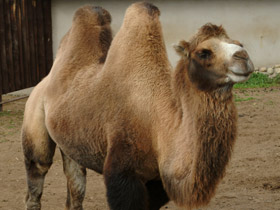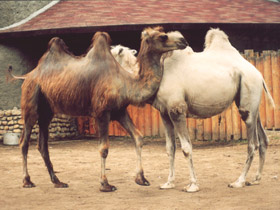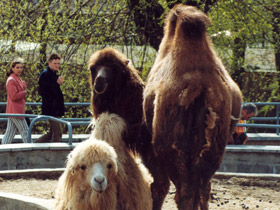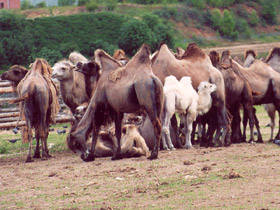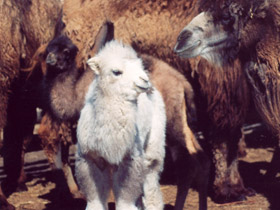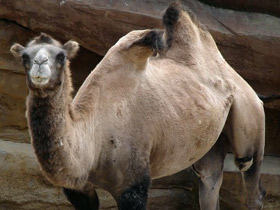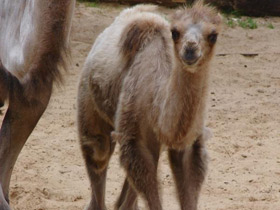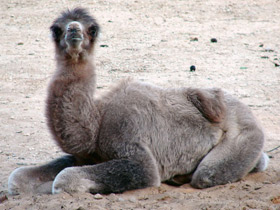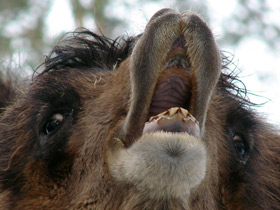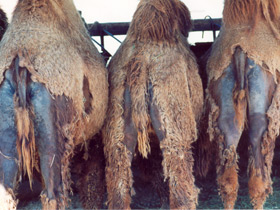Bactrian camel Camelus bactrianus
Since long time ago, the Europeans have called the camel “The Ship of the Desert”, and the Arabs described it as “tough, docile, noble, wise, and most beautiful animal in the world!” People empathy to this animal is completely understandable – the camels are the only animals who have been able to cover long distances in the vast deserts that separated Eastern countries from the rest of the world; they have been the only animals who could provide people with meat, milk, felt, and wool, serving the roles of the horse, sheep, and cow at the same time. There are only two living species of camel remaining, the double humped camel (the Bactrian) and the single humped camel (the Dromedary). The single humped camels inhabited deserts of Africa and Arabian peninsula but have not survived to our days, when wild Bactrian camels are still found in Gobi desert though the size of the wild population is estimated at less than 600 specimens. The Bactrian camels have been included in the IUCN Red List of Threatened Species and are strictly protected.
Unlike the Dromedaries, stocky and relatively short-legged Bactrian camels are perfectly adapted not only to the very hot weather, but also to extremely cold conditions typical for Central Asian deserts – the are able to withstand temperature differences of 80 degrees! Their incredibly thick shaggy coat saves them in brutal winters, but soft, downy inner coat of the camels is a good insulator protecting the animals not only from freezing, but also from overheating. It is not surprising that the camel feels comfortable even in very hot weather: when the temperature of the coat on its back reaches 80 degrees Celsius, the skin beneath the fur has a temperature of just 40 degrees! “The Ship of the Desert” is not afraid of the sandstorms: dust and sand will not get into its eyes or lungs because it has long thick eyelashes and sealable nostrils. While resting, the camel lies on the ground supporting its body with its knees, ankles, and chest – all those areas are bare but protected from the hot sand with calloused pads. The Bactrian stands from 1.8 to 2 м at the shoulders, not including the size of its bumps which become floppy and flabby when the fat in the animal humps gets used up. The vegetation in the desert is scarce, but the camel’s stomach can provide fermentation of the most rough and low energy density foods, and the animal readily eats prickly, dry, and hard-leaved plants that are ignored by other animals. Camels have excellent eye sight and hearing – they may sense danger, water or rich pasturelands in a distance of 40-60 meters. “The Ships of the Desert” are extremely tough: they can travel about 40 kilometres a day, carrying the load of up to 300 kg (almost a half of their own body weight), and when ridden, they can cover the distance of over 100 km a day at a speed of 10 to 12 kilometres per hour.
The most famous quality of the camels is of course, their legendary ability to endure long periods of travelling without water. Indeed, the camel can withstand dehydration that would kill other mammals; the camel can survive if it loses a body water equal to 40% of its total body weight, while other homoiothermal animals will die if they lose water equal to 20 percent of their body weight. There are several mechanisms that make this possible. The camel’s kidneys can absorb significant volumes of water from urine and return the water back to the body. Specific shape of the camel erythrocytes makes it possible to traverse small capillaries when the viscosity of the blood increases during dehydration because the erythrocytes are oriented with the long axis in the direction of the blood flow. Fat stored in the humps (up to 150 kilograms!) does not breakdown producing water as was thought earlier, but provides nutriment in times of starvation and serves as insulation. During long travelling the fat is gradually runs out and the camel loses weight, but once it reaches a water source, it may drink up to 200 litres of water at one session and quickly recover.
In the wild, the Bactrian camels live in groups of 5 to 20 animals consisting of the females, their offspring, and a dominant male. During breeding season the males become restless and very aggressive; they constantly produce roaring-gurgling sounds, and run around; their lips are covered with frosty saliva. Fighting competitors, they push each other with their necks trying to bring the enemy down, and sometimes may bite or kick. After gestation lasting 13 months, the female gives birth to one calf weighing about 40 kilograms. The newborn can walk after its mother in two hours after birth. The female keeps nursing the calf till it reaches 1.5 years of age, though the young camel starts eating plants when it is 6 month old. Young camels live with their mothers till the age of two years.
The wild Bactrian camel (Camulus ferus) was first described by Nikolai Przhevalsky in 1883. The wild Bactrian camel is legally protected in China and Mongolia, but its numbers continue to decrease and the wild population is threatened with extinction.
It is speculated that the two-humped camels were first domesticated about 4,500 years ago in the territories of the west of Iran and south of Turkistan. Domestic Bactrian camels are common in many areas spreading from Kalmykia, Volga River and Ural regions, and Turkey to Northern Iran, Afghanistan, Transbaikal, Tibet and Eastern China.

















